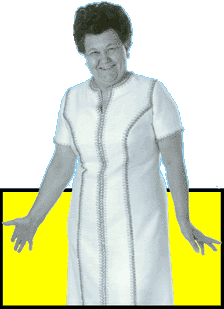Who is Mrs. Miller?
In April 1966, under the roar of Vietnam and a raging counter-culture, emerged a singer like no other. Off-pitch and off-tempo, a 59 year-old grandmother would perform rock standards such as "Hard Days Night", "Downtown", and "These Boots and Made for Walking" in a bizarre operatic style. Often considered the worst pop star of all time, she rode the line between farce and reality, as the reputable Capitol Records promoted the so-called "new sound" without cracking a smile. Her name was Elva Connes Miller, but on stage she was known simply as Mrs. Miller.
Within a period of 18 months, Mrs. Miller attained unbelievable fame. Her debut album "Mrs. Miller’s Greatest Hits" sold 250,000 copies within 3 weeks. She made appearances on Johnny Carson’s Tonight Show, Ed Sullivan, Art Linkletter’s House Party, Laugh-In, the Hollywood Palace with Jimmy Durante, and the feature film "The Cool Ones" with Roddy MacDowell. Her Petula Clark cover "Downtown" even broke onto the Billboard singles chart. She went on to release two more albums for Capitol, including the

country themed "The Country Soul of Mrs. Miller." She even donned a muumuu and army boots to perform for the troops in Vietnam with Bob Hope.
But the music of Mrs. Miller is not nearly as strange as the story of her rise to fame. Originally from Dodge City, Kansas, Elva married John Miller (a man thirty years her senior) in 1934 and moved to Claremont, California. She had long been an aspiring singer, having performed at KGNO back in Dodge City and with the local choir in Claremont. While in a private studio session recording vanity 45s for family and friends, Elva Miller caught the attention of a young arranger/pianist named Fred Bock. He had her try the pop hit "Downtown" which provided a startling result. Bock took the demo to record producer Lex de Azevedo and suddenly Elva was back in the studio, recording an entire album for Capitol Records.
The eventual question was always- "Is Mrs. Miller in on the joke?" After all, this was a joke wasn’t it? The answer was illusive, intangible in an Andy Kaufman sort of way. Elva later revealed, "I don’t sing off-key and I don’t sing off-rhythm. They got me to do so by waiting until I was tired and then making the record. Or they would cut the record before I could become familiar with the songs. At first I didn’t understand what was going on. But later I did, and I resented it." Capitol told her that it was an "experiment" and Elva played innocent. Eventually she began to truly embrace the "so bad, its good" gag. A remarkable aspect of Mrs. Miller’s music, was her famous "ice-whistling" technique. She would hold a piece of ice in her mouth for 20 minutes before performing, in order to achieve a "good tight pucker" for her legendary whistle solos.
But the appeal of Mrs. Miller goes beyond a mere novelty act. Although she was aware of the joke, she was also still the genuine article. It was her honesty and sincerity that attracted her most devote fans, many which admit that they were drawn to Mrs. Miller because they found someone that they could relate to. Skip Heller author of the biographical article "Plan 9 from Claremont" explains, "As does the work of Plan 9 director Ed Wood Jr., Mrs. Miller gives us something in which there is so much human charm that we are disarmed by it. We laugh at first, because the ineptitude is so striking- but the enthusiasm, heart, and above all, frailty, touches the heart. Ed Wood and Elva Miller make us happy, and in ways that neither could ever have foreseen."
After three albums, Mrs. Miller was dropped from Capitol Records, only to be picked up by the small Amaret label. On her forth album, "Mrs. Miller Does Her Thing" the reality of Elva Miller was even further distorted. On the cover she is pictured in a psychedelic hippie dress, with an outreached plate of green brownies. The album included songs such as Mary Jane, Green Tambourine, Green Thumb, Renaissance of Smut, and the infamous Granny Bopper. Elva was completely unaware of the drug symbolism until the album was already in stores. The song "Mary Jane" became the theme for a feature film of the same name, which featured pop star Fabian as high school teacher fighting a marijuana gang. Record executives had transformed the image of Mrs. Miller into an aspiring late sixties drug icon. Whereas Elva was happy to join in on the joke before, here is when the joke began to betray her.
In the early seventies, Mrs. Miller broke from the major record labels and went out on her own. She was determined to make it with straight material and a new image. Two 45 singles were released on her own label- Mrs. Miller Records, but the sales were disappointing. Mrs. Miller eventually disappeared from the spotlight.
Her later years were spent living in Hollywood and eventually in Northridge, CA (near Los Angeles in the San Fernando Valley). With the death of her husband, she spent her time fondly caring for her niece and nephews and contributed frequently to many charities and organizations. She was frequently seen at the LA Music Center's Dorothy Chandler Pavilion, where she was an avid classical music fan.
Elva Miller's apartment building collapsed in the 1994 Northridge Earthquake and she was quickly moved to a convalescent hospital in Vista, California. She passed away in Vista in 1997.
Elva will be remembered lovingly by many. Although it was the music that made her famous, it was her generosity, compassion, dedication to individualism, and her unwavering commitment to her own personal ideals that made her a legend. Many might see her as simply a "one joke wonder," but to those that loved and truly understood her, she would always be a star.